Full text
PDF
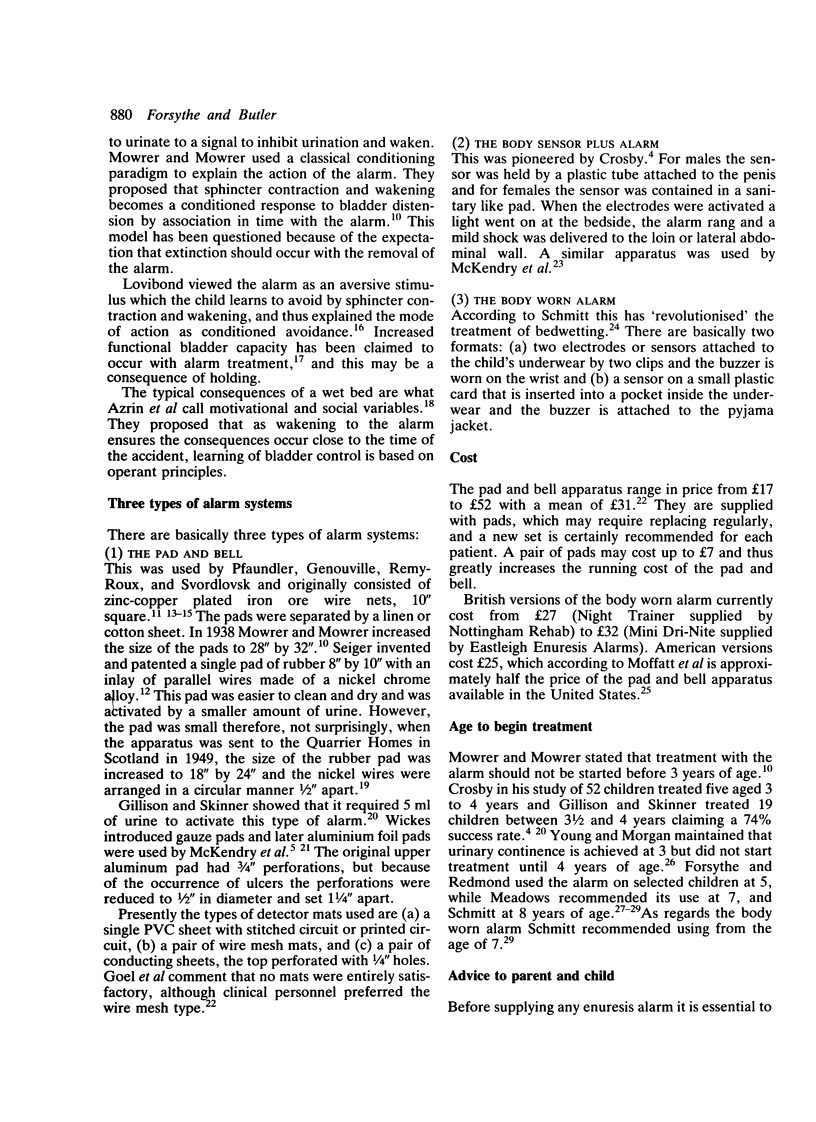
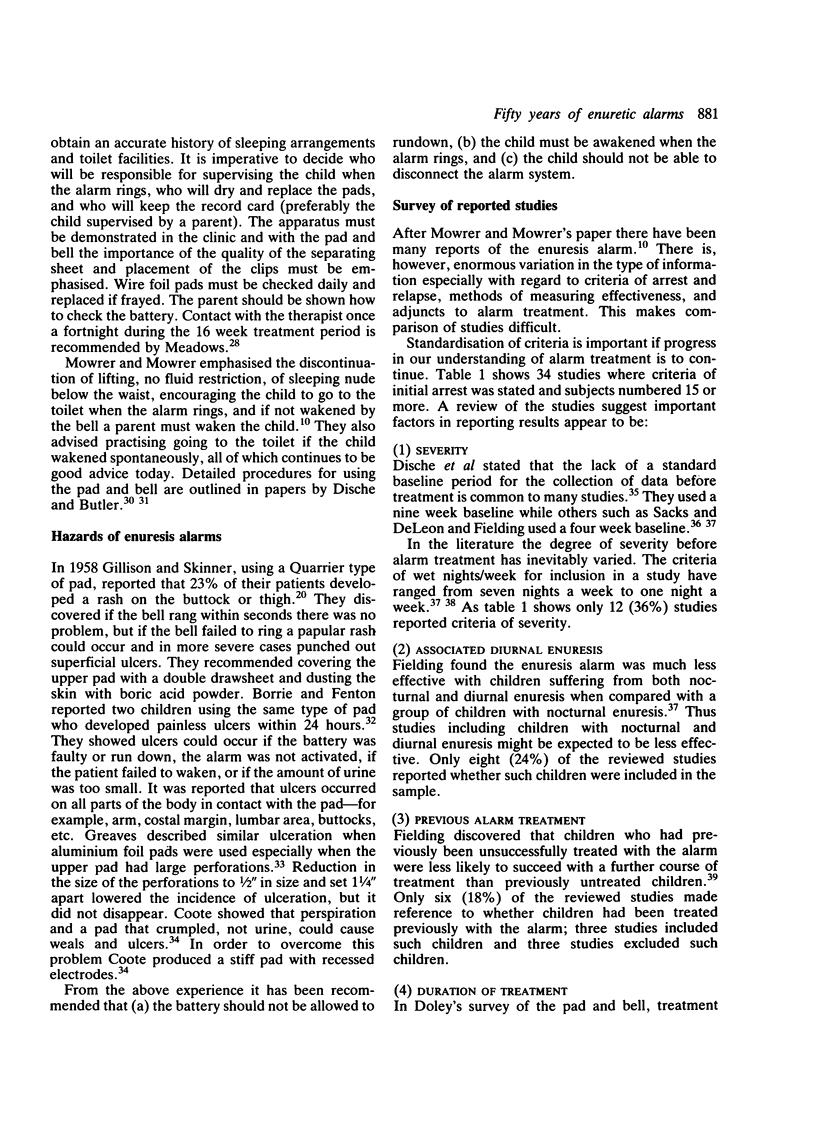
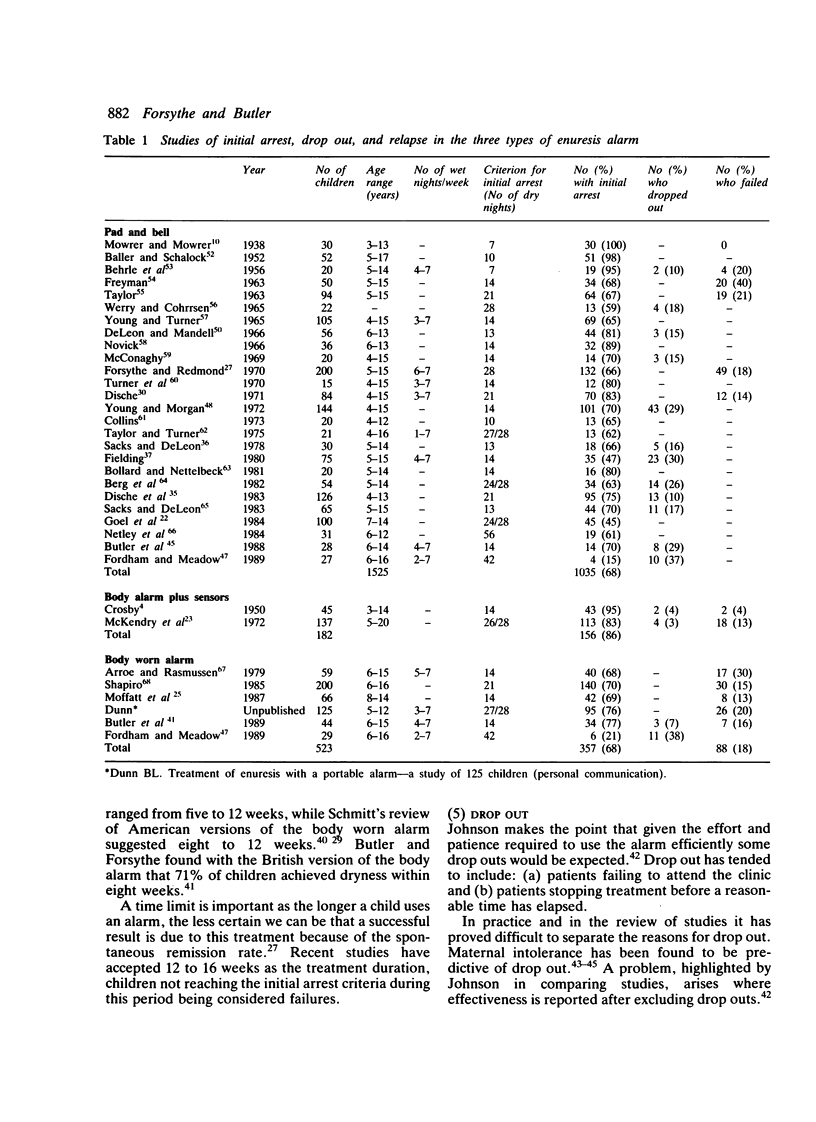
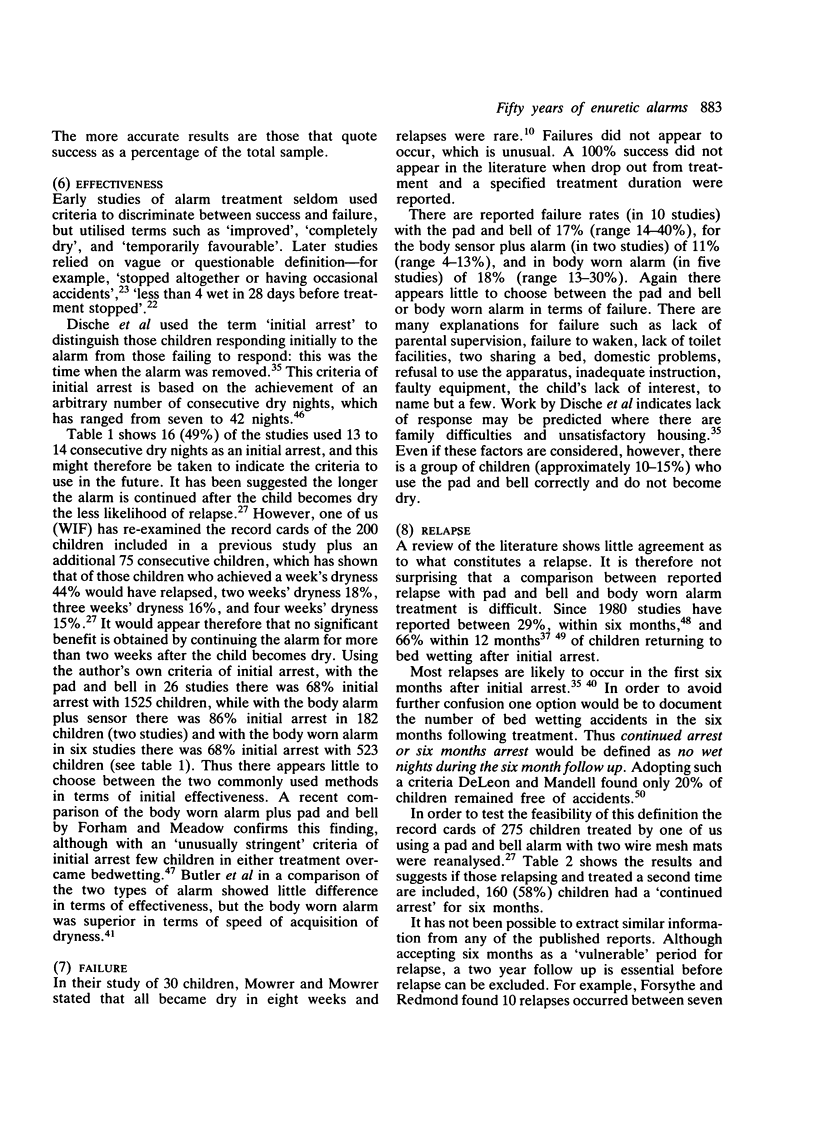
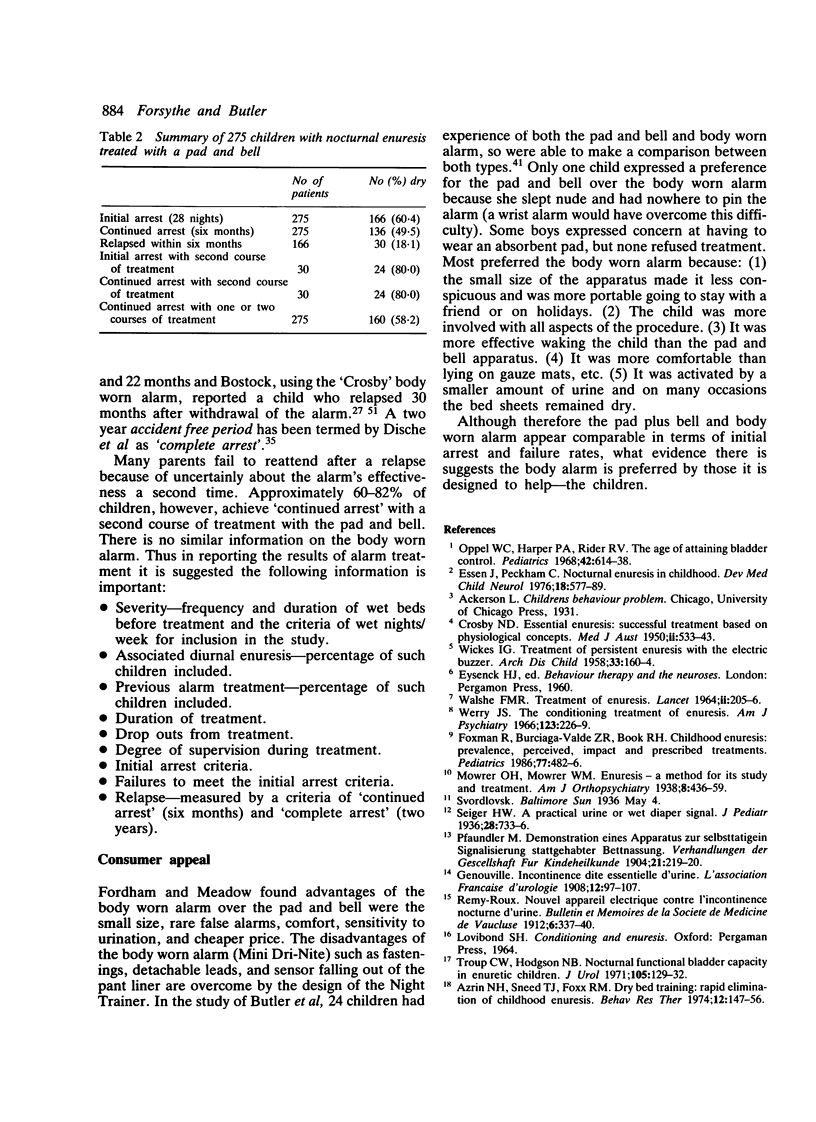
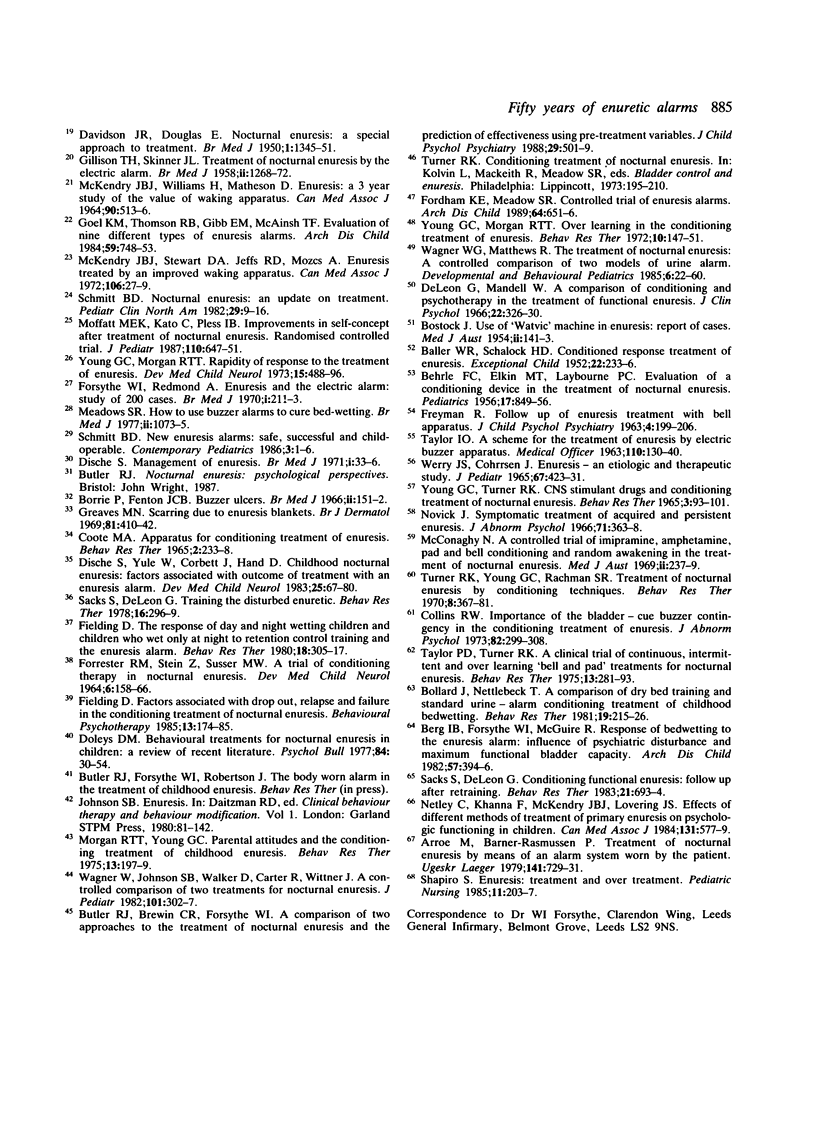
Selected References
These references are in PubMed. This may not be the complete list of references from this article.
- Arrøe M., Barner-Rasmussen P. Behandling af enuresis nocturna med kropsbåret ringeapparat. Ugeskr Laeger. 1979 Mar 12;141(11):729–731. [PubMed] [Google Scholar]
- Azrin N. H., Sneed T. J., Foxx R. M. Dry-bed training: rapid elimination of childhood enuresis. Behav Res Ther. 1974 Sep;12(3):147–156. doi: 10.1016/0005-7967(74)90111-9. [DOI] [PubMed] [Google Scholar]
- BEHRLE F. C., ELKIN M. T., LAYBOURNE P. C. Evaluation of a conditioning device in the treatment of nocturnal enuresis. Pediatrics. 1956 Jun;17(6):849–856. [PubMed] [Google Scholar]
- BOSTOCK J. Use of watvic machine in enuresis; report of a case. Med J Aust. 1954 Jul 24;2(4):141–143. doi: 10.5694/j.1326-5377.1954.tb66326.x. [DOI] [PubMed] [Google Scholar]
- Berg I., Forsythe I., McGuire R. Response of bedwetting to the enuresis alarm. Influence of psychiatric disturbance and maximum functional bladder capacity. Arch Dis Child. 1982 May;57(5):394–396. doi: 10.1136/adc.57.5.394. [DOI] [PMC free article] [PubMed] [Google Scholar]
- Bollard J., Nettelbeck T. A comparison of dry-bed training and standard urine-alarm conditioning treatment of childhood bedwetting. Behav Res Ther. 1981;19(3):215–226. doi: 10.1016/0005-7967(81)90005-x. [DOI] [PubMed] [Google Scholar]
- Borrie P., Fenton J. C. Buzzer ulcers. Br Med J. 1966 Jul 16;2(5506):151–152. doi: 10.1136/bmj.2.5506.151. [DOI] [PMC free article] [PubMed] [Google Scholar]
- Butler R. J., Brewin C. R., Forsythe W. I. A comparison of two approaches to the treatment of nocturnal enuresis and the prediction of effectiveness using pre-treatment variables. J Child Psychol Psychiatry. 1988 Jul;29(4):501–509. doi: 10.1111/j.1469-7610.1988.tb00740.x. [DOI] [PubMed] [Google Scholar]
- COOTE M. A. APPARATUS FOR CONDITIONING TREATMENT OF ENURESIS. Behav Res Ther. 1964;2(2-4):233–238. doi: 10.1016/0005-7967(64)90021-x. [DOI] [PubMed] [Google Scholar]
- CROSBY N. D. Essential enuresis: successful treatment based on physiological concepts. Med J Aust. 1950 Oct 7;2(15):533–543. doi: 10.5694/j.1326-5377.1950.tb81305.x. [DOI] [PubMed] [Google Scholar]
- Collins R. W. Importance of the bladder-cue buzzer contingency in the conditioning treatment for enuresis. J Abnorm Psychol. 1973 Oct;82(2):299–308. doi: 10.1037/h0035171. [DOI] [PubMed] [Google Scholar]
- DAVIDSON J. R., DOUGLASS E. Nocturnal enuresis: a special approach to treatment. Br Med J. 1950 Jun 10;1(4666):1345–1347. doi: 10.1136/bmj.1.4666.1345. [DOI] [PMC free article] [PubMed] [Google Scholar]
- De Leon G., Mandell W. A comparison of conditioning and psychotherapy in the treatment of functional enuresis. J Clin Psychol. 1966 Jul;22(3):326–330. doi: 10.1002/1097-4679(196607)22:3<326::aid-jclp2270220325>3.0.co;2-d. [DOI] [PubMed] [Google Scholar]
- Dische S. Management of enuresis. Br Med J. 1971 Apr 3;2(5752):33–36. doi: 10.1136/bmj.2.5752.33. [DOI] [PMC free article] [PubMed] [Google Scholar]
- Dische S., Yule W., Corbett J., Hand D. Childhood nocturnal enuresis: factors associated with outcome of treatment with an enuresis alarm. Dev Med Child Neurol. 1983 Feb;25(1):67–80. doi: 10.1111/j.1469-8749.1983.tb13723.x. [DOI] [PubMed] [Google Scholar]
- Doleys D. M. Behavioral treatments for nocturnal enuresis in children: a review of the recent literature. Psychol Bull. 1977 Jan;84(1):30–54. [PubMed] [Google Scholar]
- Essen J., Peckham C. Nocturnal enuresis in childhood. Dev Med Child Neurol. 1976 Oct;18(5):577–589. doi: 10.1111/j.1469-8749.1976.tb04204.x. [DOI] [PubMed] [Google Scholar]
- FORRESTER R. M., STEIN Z., SUSSER M. W. A TRIAL OF CONDITIONING THERAPY IN NOCTURNAL ENURESIS. Dev Med Child Neurol. 1964 Apr;6:158–166. doi: 10.1111/j.1469-8749.1964.tb02775.x. [DOI] [PubMed] [Google Scholar]
- FREYMAN R. FOLLOW-UP STUDY OF ENURESIS TREATED WITH A BELL APPARATUS. J Child Psychol Psychiatry. 1963 Dec;4:199–206. doi: 10.1111/j.1469-7610.1963.tb02121.x. [DOI] [PubMed] [Google Scholar]
- Fielding D. The response of day and night wetting children and children who wet only at night to retention control training and the enuresis alarm. Behav Res Ther. 1980;18(4):305–317. doi: 10.1016/0005-7967(80)90089-3. [DOI] [PubMed] [Google Scholar]
- Fordham K. E., Meadow S. R. Controlled trial of standard pad and bell alarm against mini alarm for nocturnal enuresis. Arch Dis Child. 1989 May;64(5):651–656. doi: 10.1136/adc.64.5.651. [DOI] [PMC free article] [PubMed] [Google Scholar]
- Forsythe W. I., Redmond A. Enuresis and the electric alarm: study of 200 cases. Br Med J. 1970 Jan 24;1(5690):211–213. doi: 10.1136/bmj.1.5690.211. [DOI] [PMC free article] [PubMed] [Google Scholar]
- Foxman B., Valdez R. B., Brook R. H. Childhood enuresis: prevalence, perceived impact, and prescribed treatments. Pediatrics. 1986 Apr;77(4):482–487. [PubMed] [Google Scholar]
- GILLISON T. H., SKINNER J. L. Treatment of nocturnal enuresis by the electric alarm. Br Med J. 1958 Nov 22;2(5107):1268–1272. doi: 10.1136/bmj.2.5107.1268. [DOI] [PMC free article] [PubMed] [Google Scholar]
- Goel K. M., Thomson R. B., Gibb E. M., McAinsh T. F. Evaluation of nine different types of enuresis alarms. Arch Dis Child. 1984 Aug;59(8):748–752. doi: 10.1136/adc.59.8.748. [DOI] [PMC free article] [PubMed] [Google Scholar]
- MCKENDRY J. B., WILLIAMS H. A., MATHESON D. ENURESIS: A THREE-YEAR STUDY OF THE VALUE OF A WAKING APPARATUS. Can Med Assoc J. 1964 Feb 22;90:513–516. [PMC free article] [PubMed] [Google Scholar]
- McConaghy N. A controlled trial of imipramine, amphetamine, pad-and-bell conditioning and random awakening in the treatment of nocturnal enuresis. Med J Aust. 1969 Aug 2;2(5):237–239. doi: 10.5694/j.1326-5377.1969.tb114670.x. [DOI] [PubMed] [Google Scholar]
- McKendry J. B., Stewart D. A., Jeffs R. D., Mozes A. Enuresis treated by an improved waking apparatus. Can Med Assoc J. 1972 Jan 8;106(1):27–29. [PMC free article] [PubMed] [Google Scholar]
- Moffatt M. E., Kato C., Pless I. B. Improvements in self-concept after treatment of nocturnal enuresis: randomized controlled trial. J Pediatr. 1987 Apr;110(4):647–652. doi: 10.1016/s0022-3476(87)80572-3. [DOI] [PubMed] [Google Scholar]
- Morgan R. T., Young G. C. Parental attitudes and the conditioning treatment of childhood enuresis. Behav Res Ther. 1975 Jun;13(2-3):197–199. doi: 10.1016/0005-7967(75)90018-2. [DOI] [PubMed] [Google Scholar]
- Netley C., Khanna F., McKendry J. B., Lovering J. S. Effects of different methods of treatment of primary enuresis on psychologic functioning in children. Can Med Assoc J. 1984 Sep 15;131(6):577–579. [PMC free article] [PubMed] [Google Scholar]
- Novick J. Symptomatic treatment of acquired and persistent enuresis. J Abnorm Psychol. 1966 Oct;71(5):363–368. doi: 10.1037/h0023822. [DOI] [PubMed] [Google Scholar]
- Oppel W. C., Harper P. A., Rider R. V. The age of attaining bladder control. Pediatrics. 1968 Oct;42(4):614–626. [PubMed] [Google Scholar]
- Sacks S., DeLeon G. Case histories and shorter communications. Conditioning functional enuresis: follow-up after retraining. Behav Res Ther. 1983;21(6):693–694. doi: 10.1016/0005-7967(83)90088-8. [DOI] [PubMed] [Google Scholar]
- Sacks S., de Leon G. Training the disturbed enuretic. Behav Res Ther. 1978;16(4):296–299. doi: 10.1016/0005-7967(78)90031-1. [DOI] [PubMed] [Google Scholar]
- Schmitt B. D. Daytime wetting (diurnal enuresis). Pediatr Clin North Am. 1982 Feb;29(1):9–20. doi: 10.1016/s0031-3955(16)34104-9. [DOI] [PubMed] [Google Scholar]
- Shapiro S. R. Enuresis: treatment and overtreatment. Pediatr Nurs. 1985 May-Jun;11(3):203-7, 214. [PubMed] [Google Scholar]
- Taylor P. D., Turner R. K. A clinical trial of continuous, intermittent and overlearning 'bell and pad' treatments for nocturnal enuresis. Behav Res Ther. 1975 Oct;13(4):281–293. doi: 10.1016/0005-7967(75)90033-9. [DOI] [PubMed] [Google Scholar]
- Troup C. W., Hodgson N. B. Nocturnal functional bladder capacity in eneuretic children. J Urol. 1971 Jan;105(1):129–132. doi: 10.1016/s0022-5347(17)61477-0. [DOI] [PubMed] [Google Scholar]
- Turner R. K., Young G. C., Rachman S. Treatment of nocturnal enuresis by conditioning techniques. Behav Res Ther. 1970 Nov;8(4):367–391. doi: 10.1016/0005-7967(70)90056-2. [DOI] [PubMed] [Google Scholar]
- WERRY J. S., COHRSSEN J. ENURESIS--AN ETIOLOGIC AND THERAPEUTIC STUDY. J Pediatr. 1965 Sep;67:423–431. doi: 10.1016/s0022-3476(65)80403-6. [DOI] [PubMed] [Google Scholar]
- WICKES I. G. Treatment of persistent enuresis with the electric buzzer. Arch Dis Child. 1958 Apr;33(168):160–164. doi: 10.1136/adc.33.168.160. [DOI] [PMC free article] [PubMed] [Google Scholar]
- Wagner W. G., Matthews R. The treatment of nocturnal enuresis: a controlled comparison of two models of urine alarm. J Dev Behav Pediatr. 1985 Feb;6(1):22–26. [PubMed] [Google Scholar]
- Wagner W., Johnson S. B., Walker D., Carter R., Wittner J. A controlled comparison of two treatments for nocturnal enuresis. J Pediatr. 1982 Aug;101(2):302–307. doi: 10.1016/s0022-3476(82)80146-7. [DOI] [PubMed] [Google Scholar]
- Werry J. S. The conditioning treatment of nuresis. Am J Psychiatry. 1966 Aug;123(2):226–229. doi: 10.1176/ajp.123.2.226. [DOI] [PubMed] [Google Scholar]
- Young G. C., Morgan R. T. Overlearning in the conditioning treatment of enuresis. Behav Res Ther. 1972 May;10(2):147–151. doi: 10.1016/s0005-7967(72)80008-1. [DOI] [PubMed] [Google Scholar]
- Young G. C., Morgan R. T. Rapidity of response to the treatment of enuresis. Dev Med Child Neurol. 1973 Aug;15(4):488–496. doi: 10.1111/j.1469-8749.1973.tb05071.x. [DOI] [PubMed] [Google Scholar]
- Young G. C., Turner R. K. CNS stimulant drugs and conditioning treatment of nocturnal enuresis. Behav Res Ther. 1965 Sep;3(2):93–101. doi: 10.1016/0005-7967(65)90012-4. [DOI] [PubMed] [Google Scholar]


